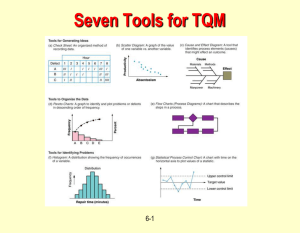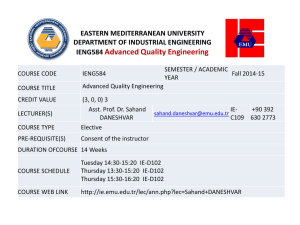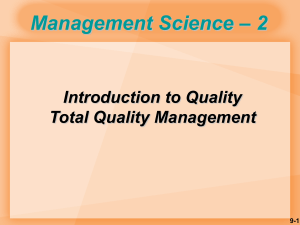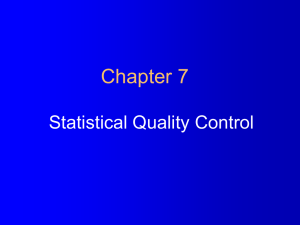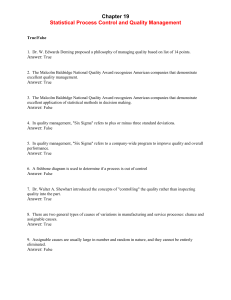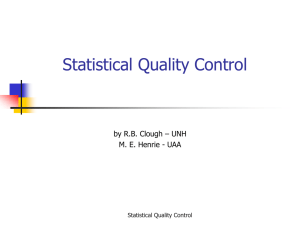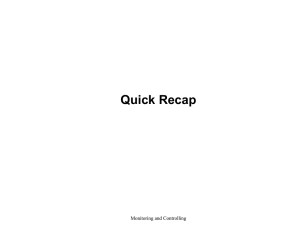Process Improvement: Analysis, Benchmarking, & Control Charts
advertisement
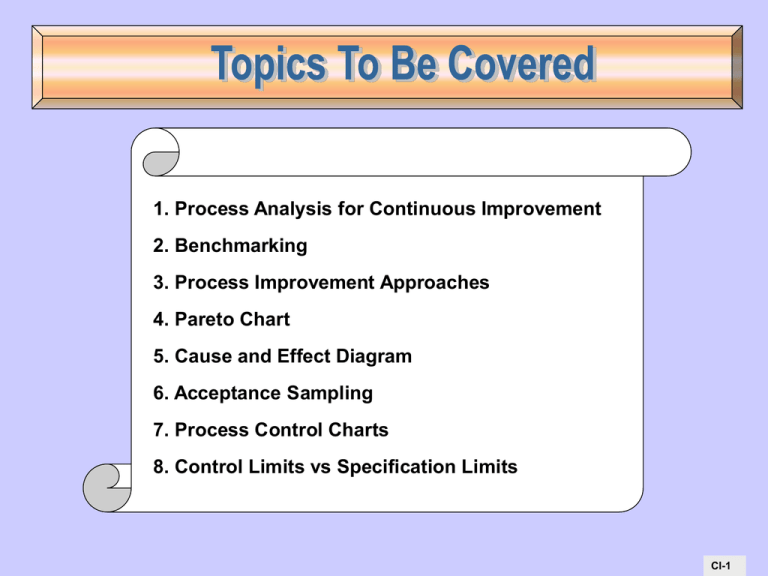
1. Process Analysis for Continuous Improvement 2. Benchmarking 3. Process Improvement Approaches 4. Pareto Chart 5. Cause and Effect Diagram 6. Acceptance Sampling 7. Process Control Charts 8. Control Limits vs Specification Limits CI-1 Variability Types Random Variability: Natural variations in the output of a process, created by countless minor errors. (not readily fixable) Assignable Variations: A variation whose cause can be identified. • Equipment or Process cause. • Type of variability that is most commonly addressed. -3 -2 2 3 -3 -2 2 3 Preferred CI-2 Areas of Waste 1. Over production – making or doing more than required 2. Waiting – for info, materials, people, maintenance, etc 3. Transport – moving people or goods around or between sites 4. Poor process design – too many/too few steps, non standardization, inspection rather than prevention 5. Inventory – raw materials, WIP, finished goods, papers, electronic files 6. Motion – inefficient layouts or poor ergonomics at workstations or in offices. 7. Defects – errors, scrap, rework, non-conformance 8. Underutilized personnel resources and creativity – ideas that are not listened to skills that are not utilized CI-3 Continuous Improvement of Process Analysis • Proactive vs Reactive • overall proactive is cheaper • Various Methods for Process Improvement • Kaizen • Process Based Management • Taguchi • General Steps for Process Improvement Model. 1. Define the problem in the context of the process 2. Identify, analyze & document the process 3. Measure current performance 4. Understand why the process is performing as it is. 5. Develop a strategy & implement the alternative chosen 6. Evaluate the results of the new process 7. Commit to continuous improvement of the process CI-4 Benchmarking • The search for industry “best practice” that lead to superior business performance. • Perspective companies to bench mark are typically leaders in their industry • Not necessarily in your industry. Benchmarking steps: 1. Identify what is to be benchmarked. 2. Identify competitive companies 3. Determine data collection method, collect data 4. Determine current performance gap 5. Project future performance levels. 6. Communicate benchmarking findings; gain acceptance 7. Establish process improvement goals 8. Develop action plan 9. Implement specific actions & monitor progress 10. Recalibrate benchmarks; return to 1. CI-5 Process Improvement Approaches • Brainstorming Generating ideas in an environment free of criticism & intimidation 4 basic principles 1. No criticism 2. No constraints 3. Build on other peoples ideas 4. Encourage participation • What are some obstacles to effective Brainstorming? • Process documentation: • Process mapping (flow charting) • Run Diagram (line chart) • Check sheets • Pareto charts • Cause and Effect diagrams CI-6 Monday, June 10, 2002 Customer Contracting Flow Processes Merchandiser Merchandiser Merchandiser Merchandiser Market Indicators review to determine Market Demand Development of Grain Contract with Customer Determination of how contract is met Communication of Contract Requirements Price Acceptable Contract Terms Location and source(s) of grain Requirements sent to appropriate facility and functions Weather Conditions Anticipated yields Commodities pricing Price Quality Delivery Date Location Logistics Location DP Current Inventory vs upcoming deliveries Existing contract demand Outcomes Measures/ Issues Facility notification Grain specifications Grain quantity Shipping instructions Carrier information Invoicing information Page 1 CI-7 CI-8 CI-9 Pareto Chart • Typically a bar chart that shows the frequency of different types of defects in a product or service. • Shows which problems may make the largest improvement if a solution is found • Separates vital problems from trivial ones. • Is tracking the number of occurrences for a specific fault the best measure for a Pareto Chart? Why or why not? 80 70 60 50 40 30 20 10 0 L Wing R Wing Cockpit Rudder CI-11 Cause and Effect Diagram • Also called a Fishbone Diagram • Useful for communicating the potential causes of an out-of-control quality characteristic and coordinating the choice of a corrective action. 1. List the concern or problem (effect) 2. Identify the factors influencing this concern. 3. List the reasons why this factor is influencing this concern. 4. Investigate potential solutions to remedy the concern. Effect CI-12 Acceptance Sampling • A form of inspection applicable to lots or batches. • Purpose is to decide if a batch satisfies a predetermined standard. • Most useful for the following conditions: • Large # of items produced in short time • Cost consequences of passing defects is low • Destructive testing is required • Fatigue or boredom caused by inspecting large # of items leads to errors. • Sampling Plan • Specify the batch size • Specify a frequency • Specify an acceptance/rejection criteria • Methods • Single Sampling • Double Sampling • Multiple Sampling • Cost & time required typically define the plan CI-13 Statistical Sampling and Control • What types of product characteristics could we sample? • What are we trying to control? Central Limit Theorem • Assumes if you have a large enough sample size then the distribution of the sample mean will approximate a normal distribution, regardless of their true distribution. • Most say that 30-50 is a large enough sample. • Use the Student t for less • Statistical sampling uses inferential statistics • The idea is that the sample taken describes the entire population. Error Types • Type I (): The sample is incorrectly rejected when the batch is good. (Producer’s Risk). Rejects the process as being out of control when it is in control. • Type II(): The sample is accepted though the batch is bad. (Buyer’s Risk) • Accepts the process as in control when it is not. • Selecting and is not trivial CI-14 SPC CHART 2.5 2.4 UCL . 2.3 . 2.2 . 2.1 . 2.0 1.9 . . . . . . _ X . 1.8 1.7 LCL 1.6 1.5 1 2 3 4 5 6 7 8 9 10 Sample CI-15 Mean Control Charts: Variable Data Mean Control Charts • Process control charts designed to detect shifts in the mean value of a process. • If the process true mean of sample is unknown then use : = • X +/- Z x = • X ; Grand Mean or average of the average observations and samples • = process standard deviation • x = / (n) 1/2 ; Standard deviation of distribution of sample mean • Hypothesis is that the process is in-control (Ho ) • If process true standard deviation of sample is not known then use X-bar chart. = - • Lower Control Limit: X - A2* R = - • Upper Control Limit: X + A2 * R • Compares each sample mean to a Grand Mean • A2 found in table (pg 310) and are based on number of observations per samples. CI-16 Range Control Chart: Variable Data Range Control Chart _ If the process variance is unknown then use a R-chart. _ • Lower Control Limit: R * D3 _ • Upper Control Limit: R * D4 • Compares each range of a sample to a mean of the range of other samples. • D3 & D4 are found in a table (pg 310) and are based on the number of observations per samples. To adequately establish the variability of a process it is recommended to use both mean and range control charts on a sample. • Accuracy • Dispersion CI-17 Mean Control Charts: Variable Data Four samples of three observations each have been taken, with actual measurements (in centimeters) shown below. Construct three sigma mean and range charts and determine if corrective action is needed. Sample 1 12.3 12.2 12.1 2 11.9 12.2 12.2 3 12.0 12.2 11.8 4 12.1 11.8 11.8 The standard deviation of the sample is known and is 0.6, construct three sigma mean chart. Use the above data. CI-18 Process Control Charts: Attribute Data What is an Attribute? Use when data is subjective and can be counted. • P chart is used when the number of both good and bad are known. • C chart is used when the number of bad parts only are known. P Chart • Underlying sample distribution is the binomial • Monitors the proportion of defects generated in a process • Constructed and used similar to the mean • Difference is we use the percent defects in a population • LCL: P - 3p • UCL: P + 3 p • p = (( P (1-P) )/ n)1/2 CI-19 Process Control Charts: Attribute Data C Chart • Underlying sample distribution is the Poisson. • large sample sizes approximate a normal distribution) • To track the countable number of defects when the ample size is the same. • The mean number of defects per unit is C and standard deviation is (C) 1/2 • If C is unknown then use C = # of defects / # of samples. • If less than zero, use zero. • LCL: C - 3 (C) 1/2 • UCL: C + 3 (C) 1/2 CI-20 Attributes Problem A town’s department of public works is concerned about adverse public reaction to a sewer project that is currently in progress. Because of this, The Commissioner of Public Works has authorized a weekly survey to be conducted of town residents. Each week, a sample of 100 residents is questioned on their feelings towards the project. The results to date are shown below. Analyze this data using an appropriate control chart with a 5% risk of Type I error. Is the community sentiment stable? Week 1 2 3 4 5 6 7 8 Opposed 10 8 12 6 4 14 8 10 Construct the appropriate control chart for the observations listed below, and determine if the process is in control using two sigma limits. Observation Number of Defects per unit 1 9 2 4 3 3 4 5 5 6 6 3 7 4 8 2 9 3 10 2 11 3 CI-21 Control Limits vs Specification Limits The quality control limits represent the natural variation produced by a process. • Does not guarantee the product meets the design specifications. • Must be able to define a way of telling if a process is capable to produce at a given design specification. • Cp defines the relationship between control limits of a process and the specification limits of design. • Cp = (USL - LSL)/6 • USL = upper spec limit • LSL = lower spec limit • = Standard deviation of the process • can be approximated by R/D2 • Cp = 1 says process is barely capable • Cp > 1 says Process is capable • Cp < 1 says process is not capable • Usually strive for a Cp = 1.33 or better Cp does not consider how well the process is centered within the limit CI-22 Control Limits: Cpk Cpk is used to define if the process and the spec limit are centered. • Compute by • finding difference between each of the specification limits and the mean • identifying the smaller difference • divide difference by three standard deviations of the process. • Cpk = Min [ ((Upper spec - Process mean)/3), ((Process mean - Lower Spec)/3)] Limitations of Capability Index 1. The process may not be stable. • capability index is meaningless. 2. The process output may not be normally distributed. • Inference about fraction of output that is not acceptable will be incorrect. 3. The process is not centered • if the Cp index is used a misleading result is given. CI-23 Control Limits Problems Studies on a machine that molds plastic water pipe indicates that when it is injecting 1-inch diameter pipe, the process standard deviation is 0.05 inches. The one-inch pipe has a specification of 1-inch plus or minus 0.10 inch. What is the process capability index (Cp)? Is the process capable? The specification limit for a product is 8cm and 10 cm. A process that produces the product has a mean of 9.5cm and a standard deviation of 0.2cm. What is the process capability, Cpk? Is the process capable? CI-24
